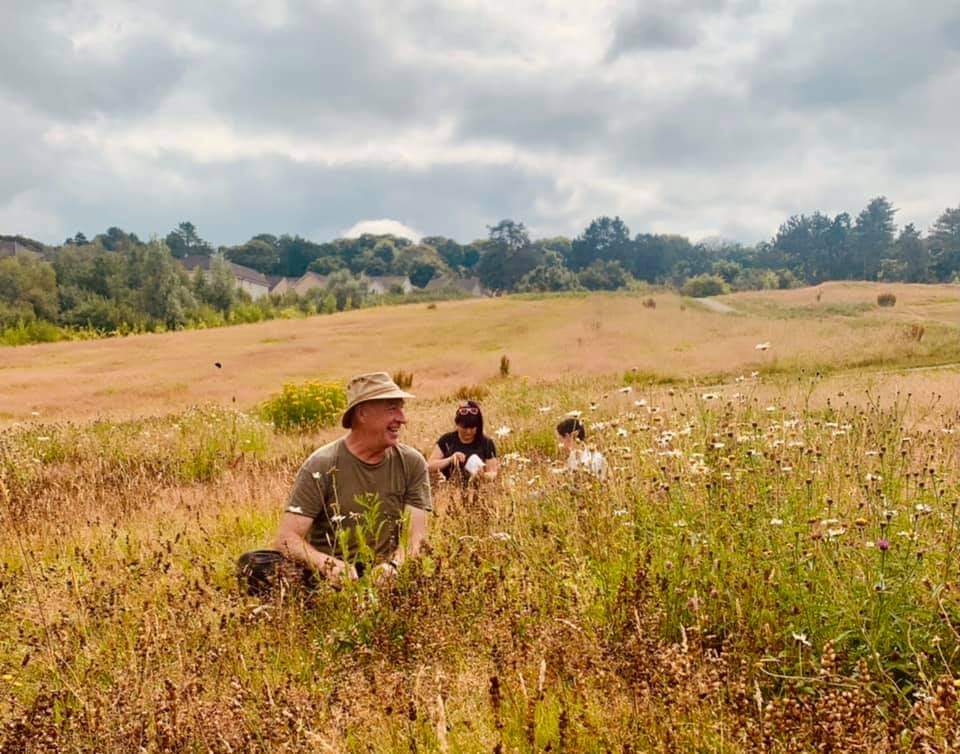We continue our series of articles looking at the fantastic projects which entered the Keep Scotland Beautiful pollinator-friendly category. Today Catherine Lawson introduces to the work of ‘Bonnie Dundee’.

By Catherine Lawson
We are ‘Bonnie Dundee’ who are an It’s Your Neighbourhood (IYN) group which links in with the citywide Beautiful Scotland partnership of local communities, gardens, allotments, other IYN and Friends groups, and parks across Dundee. We formally began our focus on pollinators in 2019, starting small and now in our third year, like our planting, our ideas have just kept growing.
There are five areas in Dundee City Centre, which we plan, plant, and maintain and we have always been mindful of biodiversity and kept an eye on what wildlife visit our displays. We have also had small areas of wildflowers since 2017, including around our orchard planters and in a large community herb bed.

One of our areas is a main street through the city centre with fourteen large hexagonal planters. In 2019 we noticed an extraordinary number of ladybirds. This started us off on a mission to identify them, which lead to us displaying pollinator ID sheets, to pass on our interest to the public, increase knowledge of pollinators and their decline and hopefully pass on our enthusiasm too. Our notices included common bees, ladybirds and butterflies, information about how to get in touch with us and encouraging people to share what they’d seen with us. This was also the year of the Painted Lady, and added even more interest, or maybe excitement is a better word.
At the start of the pandemic in 2020 we noticed through social media that a small Arbroath group, Seeds of Hope Scotland, were giving away locally sourced wildflower seeds to interested groups and hoping to spread some joy along the way. We applied for 95 packets and so our pollinator project started.



Working with Dundee City Council we contacted all the city groups offering free seeds on the provision that they send us photos of the finished result. We explained that we were handing them out to spread some cheer, help pollinators and raise awareness of their decline. We also wanted to generate some enthusiasm for learning about them, being able to identify them, as well as motivating people to get involved. We used social media and all the seeds went within a few days.
The result was amazing for us, the pollinators and the growers and the resulting video of all the pictures did indeed spread much needed joy. It also brought groups together on a common theme and made individuals planting in their own gardens feel part of a bigger city-wide whole. We entered our project into the NatureScot Pollinator Award and to our surprise we won!

In 2021, we realised that this project had the potential to really grow throughout Dundee, so we decided to pass it on to the city-wide Beautiful Scotland group, with our members still actively involved. We renamed it ‘Flowering Dundee’ and so the Beautiful Scotland project began!This year, Seeds of Hope became a social enterprise and we used the award money to buy 120 seed packets from them, then we linked in with Dundee City Council’s wildflower areas, Dundee University Botanical Garden’s ‘Re-Wilding’ project, and Keep Scotland Beautiful too.
Heading towards summer, along with our 120 packets of Seeds of Hope, we collected 12 packets of sunflower seeds from Morrisons, 30 packets of Dundee City Council’s wildflower annuals mix, and 6 seed balls from Keep Scotland Beautiful giving us 168 packets to share across Dundee. These were distributed among 3 church gardens, 2 primary schools, 19 community gardens, 3 parks and 16 individuals!
The project was further extended by receiving 200 sunflower plants from Dundee University Botanic Gardens which we handed out as well. We added to our identification notices to include hoverflies and moths, with links to find out more. We made our second video with even more contributions than the first and we received even more positive feedback.
Another big influence on us has been COP26 and the climate crisis, with the emphasis on restoring biodiversity. There is so much information out there on what we all ‘should’ do, and often with confusing jargon, so we decided to start with small steps and encourage everyone to do the same. We used the quote by Sally Nex from her book ‘How to Garden the Low Carbon Way’ to inspire people to start planting – even if it was just in a pot! The quote is . . .
‘A billion tiny actions have brought us to the edge of environmental crisis, and a billion tiny actions can pull us back from the brink’.

Throughout ‘Flowering Dundee’ we have tried to encourage as many people to take part as possible and help people feel that they can give it a go too. We encourage pollinator friendly gardening and highlight the methods you can use, such as; ideas for the best types of flowers, the importance of dandelions and nettles and keeping a small ‘untidy’ area, and at the end of the season to save leaves and stalks, especially sunflowers, to provide shelter for insects. We wanted to highlight that everybody can take these simple steps to help reduce their environmental impact and help pollinators, and that all these small changes as individuals can add up to a larger impact collectively.
Our ‘little acorn’ of an idea has grown faster and spread wider than we expected in such a short space of time, but luckily there are still many stages of Flowering Dundee to look forward to before, like the oak, it reaches full maturity, and we are excited to see what the future will bring.
Please visit
https://www.dundeecity.gov.uk and search for Beautiful Scotland
Bonnie Dundee IYN | It’s Your Neighbourhood (keepscotlandbeautiful.org)



























